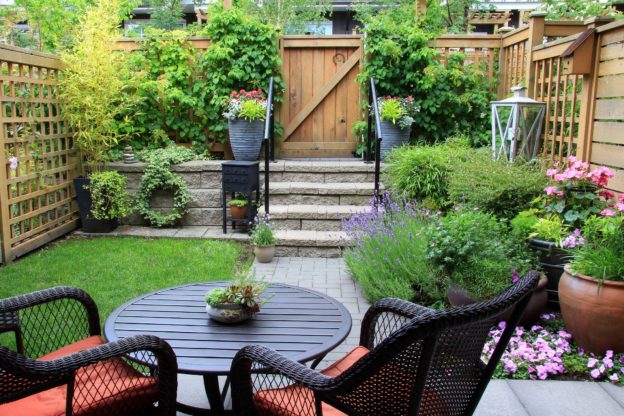Budget Garden Ideas
The following is an editorial written for the Wilkinson Grant Inspire Magazine for Spring/ Summer 2018. It was written by our Managing Director Tammy Falloon about how to improve the appearance of your garden to help the sale of a property. All of these suggestions can also be used as budget garden ideas to enhance your garden- regardless of whether or not you are selling!
Adding value
A well-maintained garden can add a decent percentage to your property value, but if you are looking to move house the last thing you’ll want to do is invest in it. There’s no need to spend a fortune though as a few well thought out additions can reap dividends and can move with you!
We suggest you do the following;
-

A planted container showing that a small pot can bring a huge punch of colour.
1. Think of your garden as an outside room and therefore give it a good clean up. Mow the lawn, sweep up debris and pull out all of the weeds.
- 2. Invest in some solar lighting. Any evening viewings will benefit from the warm inviting atmosphere and daytime viewers will see that the space can be useable at night. You can take the lights with you when you move and since they are solar powered there’s no running cost.
- 3. Privacy is important so if you have an unsightly view or nosy neighbour consider investing in a fence panel or some large plants in pots to disguise the gap.
- 4. Be sure to de-clutter and organise any outbuildings or sheds that you may have. Buyers will be looking for as much storage and living space as possible.
- 5. Use props. Show how functional the outdoor space can be by perhaps getting some garden furniture or a BBQ. You can also buy outdoor mirrors which give the illusion of more space. If you get the chance, dress your furniture too- a lit patio heater or candle will add to the atmosphere.
- 6. Jazz up your front garden. Most buyers will be sat in their cares looking and assessing from the road before their viewing so make sure that the front garden gives a positive impression. Buy brightly coloured hanging baskets and plant up colourful containers with plants. Remember you can take these with you to your new home.
- 7. Don’t forget to add some plants indoors too. Currently there is a real trend for green houseplants and their health benefits. Succulents are really fashionable plants and very easy to look after.
- 8. Appeal to all the senses, pick some plants with a fragrance. You want to be the house that is remembered by your potential buyer so position some fragrant plants near a door or pathway for some added impact. Plants like roses, lavender and rosemary are always favourites.
Our top plants for colour this spring and summer
- – May: Bedding plants. These plants pack a punch when it comes to bold, brash colour. They are typically annuals (meaning that they only last one season) and ideal for planting in pots, hanging baskets and the front of plant borders. Look out for Petunias, Geraniums and Lobelias in particular.
-

An Aquilegia
– June: Herbaceous perennials. These are the plants made for cottage gardens and chocolate box photos. They are goof value in that the plants die down in winter but will re-shoot the following spring. Our favourites include Hardy Geraniums, Peonies, Heleniums and Aquilegias.
– July: Roses. We grow over 200 cultivars of roses including the English David Austin varieties. If you want to grow a rose in a pot then take a look at our patio varieties. Our favourites include Flower Power Gold and Sweet Dream.
- – August: We love Callistemon (commonly called the bottle brush plant). Perfect for a warm sheltered spot this shrub has vivid flower spikes that look like red bottle brushes. We also love late summer flowering herbaceous plants like Echinacea, Phygelius and Bergamot (Monarda).

An Aster
– September: Sedums are a must. They look great in pots, attracting lots of butterflies and bees. They are super low maintenance plants and when the flowers go over, the brown heads are also attractive. Asters are also a great pick with their daisy like flowers that last into the autumn.







